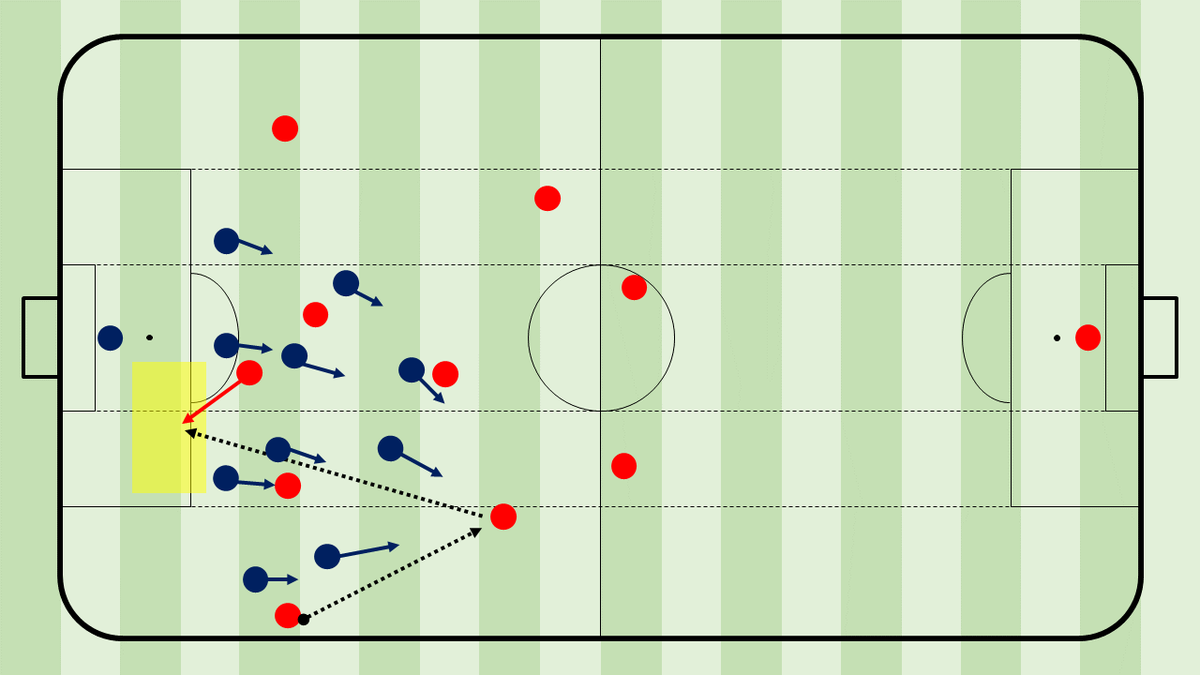
Tactical Theory: The various ways to attract pressure in possession
- accessing space in between the lines
- getting in behind
- creating a free man
@SundayShare10 #SundayShare #Tactics
[THREAD]
- accessing space in between the lines
- getting in behind
- creating a free man
@SundayShare10 #SundayShare #Tactics
[THREAD]

Major aims in possession are getting in between the lines of the opponent and in behind. However, that’s what most defensive sides try to restrict by using a compact block with little space in between the lines and or a deep block to make it difficult to get in behind.
Defensive sides are getting better and better and offensive sides continuously fail to crack compact and or deep blocks. One way to access space in between the lines or in behind is by intentionally attracting pressure.
This thread analyses the various ways to lure pressure.
This thread analyses the various ways to lure pressure.
First of all, to attract pressure, we have to examine common pressing triggers of a defensive side to use them for our advantage and effectively invite pressure:
Backwards view, back pass, goalkeeper having the ball, horizontal pass, pass to fullback.
Backwards view, back pass, goalkeeper having the ball, horizontal pass, pass to fullback.
Playing intentionally to a player with a backwards facing view can be very effective to attract pressure. Most opponents pressure a player with a backwards facing view as he then can only play backwards, which is no direct danger for the defensive side.
If one defender moves up to press, spaces behind him can open up or it results in a free player. Then, it’s important to have a well-connected structure to play into this free space. At times, even more than one defender can be invited to press.
A way to use a backwards facing view are 3rd man combinations. This refers to player A indirectly passing to player C, using player B. The possession side can use the 2nd player with a backwards facing view to lure pressure and then access the 3rd man with space.
Next up, we have the back pass. Again, most opponents move up after a back pass because it is no danger for the defensive side. Intentionally using backwards passes can be useful to open spaces either in between the lines ...
A possibility to combine these two methods is an up-back through combination. This refers to a vertical pass, a lay off back pass and a through pass. The vertical pass again attracts pressure due to the bad body shape and the back pass also invites pressure.
The player, who makes a run in behind also often goes unnoticed by the defensive side and therefore has a dynamical advantage. He can then make use of the opened space through the attraction.
Moreover, against more high pressing teams, the usage of the goalkeeper can also be a way to attract pressure, as he is usually the worst player on the ball, it invites the opponent to put him under pressure.
If the goalkeeper is good enough with the ball, teams should definitely make use of him in possession. Also, simply because it creates an overload, as the opponent’s keeper doesn’t press.
Again, this method can be combined with the other ones mentioned above. A basic example here:
Side note: Provoking pressure and having a structure with short distances often leads to a defender, who presses, holding on his run to put another player under pressure, who is near him. This effectively leads to even more spaces and the defensive side is unstable.
Other ways to attract pressure through passing are intentionally using horizontal passes, short passes or passing to the fullback. To use this approach, it’s important to have players that are good with the ball and are press-resistant.
Lastly, an effective way to attract pressure against low blocks is the dribbling of a centre back. There is always a defender that has to move up to put him under pressure because if that doesn’t occur, he can run through on goal.
Mostly a player, who initially marked another player has to move up on the centre back, leaving his opponent free. The advancing centre back can maybe access him directly or through another player. 

Conclusion:
Attracting pressure has become more and more important in modern football. Intentionally using these methods can be an effective way to both crack high pressing teams and low blocks.
I hope you enjoyed this thread! Feedback is appreciated in any form whatsoever!
Attracting pressure has become more and more important in modern football. Intentionally using these methods can be an effective way to both crack high pressing teams and low blocks.
I hope you enjoyed this thread! Feedback is appreciated in any form whatsoever!
• • •
Missing some Tweet in this thread? You can try to
force a refresh










